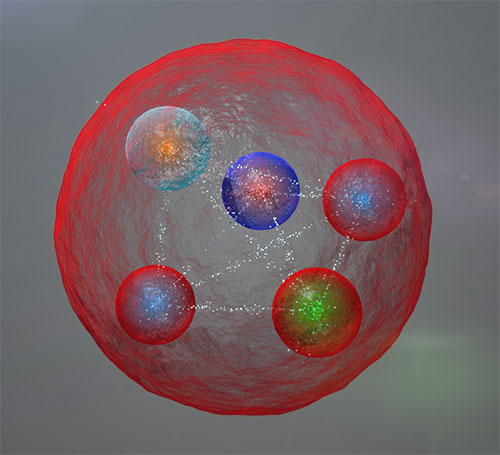Illustration of the possible layout of the quarks in a pentaquark particle such as those discovered at LHCb. The five quarks might be tightly bonded (shown), or they might also be assembled into a meson (one quark and one antiquark) and a baryon (three quarks), weakly bonded together (not shown). Images: © CERN / LHCb Collaboration.
NEWPORT NEWS, VA. – CERN, the European Organization for Nuclear Research, has announced that its LHCb experiment has discovered two possible pentaquark particles that haven't been seen before. If confirmed, these new particles will herald the discovery of a whole new class of particles.
Pentaquarks gained international attention in 2003, when evidence for a lighter cousin of the pentaquarks announced by CERN was thought to have been found by experimenters at SPring-8 in Japan, the Department of Energy's Thomas Jefferson National Accelerator Facility, the Alikhanov Institute for Theoretical and Experimental Physics (ITEP) in the Russian Federation and the ELectron Stretcher and Accelerator (ELSA) in Germany.
"The possible pentaquark sightings in experiments in the early 2000s were not confirmed by more precise measurements subsequently performed here at Jefferson Lab and elsewhere." says Robert McKeown, Jefferson Lab's Deputy Director for Science. "But the announcement from the LHCb Collaboration reports evidence of much heavier pentaquarks, which would be completely different particles. If these particles seen at CERN truly exist, then there may be implications for other studies that can be performed at Jefferson Lab and other facilities. So these new results are of great interest to our scientists and others around the world."
The prospect of a pentaquark discovery is exciting news, because pentaquarks break the rules of how the building blocks of protons and neutrons are ordinarily found. These building blocks, quarks, have always been found glued together into groups of two or three. For instance, protons and neutrons are each made of three quarks.
However, while it's not been definitively confirmed in experiment, it is theoretically possible for quarks to arrange themselves in a five-some in a family of particles known as pentaquarks. Pentaquarks are thought to be composed of certain combinations of the six flavors of quarks – up, down, strange, charm, bottom and top – and anti-quarks – anti-up quark, anti-down quark, anti-strange quark, anti-charm quark, anti-bottom quark and anti-top quark.
In 2003, researchers thought that they had found hints in their data of such a five-some called the Θ+(1540), or Theta-plus, pentaquark. This pentaquark was thought to be built of two up quarks, two down quarks and an anti-strange quark. Its mass, measured in millions of electron-Volts, was thought to be 1540 MeV. However, several dedicated pentaquark searches carried out soon after the initial announcements provided more detailed data that eventually over-ruled the potential pentaquark signals.
In a paper recently submitted to Physical Review Letters, the LHCb Collaboration at CERN announced the discovery of two, new possible pentaquarks named Pc(4450)+ and Pc(4380)+. These pentaquarks are thought to be comprised of two up quarks, one down quark, one charm quark and one anti-charm quark, and their masses are thought to be 4450 MeV and 4380 MeV.
"It's unlikely that researchers will be able to confirm these results at Jefferson Lab, because these possible pentaquarks are much more massive than particles that are routinely produced in experiments carried out with Jefferson Lab's accelerator," McKeown says. "While these possible particles are beyond our current experimental reach, we are excited to learn about these results and what they may mean for our understanding of the sub-atomic realm."
Meanwhile, the LHCb scientists will continue their research at the LHC, and they expect that the new data will allow them to get more information on the particles they've discovered.
Link to the paper on ArXiv: http://arxiv.org/abs/1507.03414
More on the LHCb collaboration website: http://lhcb-public.web.cern.ch/lhcb-public/Welcome.html#Penta
About CERN:
CERN, the European Organization for Nuclear Research, is the world's leading laboratory for particle physics. It has its headquarters in Geneva. At present, its Member States are Austria, Belgium, Bulgaria, the Czech Republic, Denmark, Finland, France, Germany, Greece, Hungary, Israel, Italy, the Netherlands, Norway, Poland, Portugal, Slovakia, Spain, Sweden, Switzerland and the United Kingdom. Romania is a Candidate for Accession. Serbia is an Associate Member in the pre-stage to Membership. India, Japan, the Russian Federation, the United States of America, Turkey, the European Union, JINR and UNESCO have Observer Status.
Contact: Kandice Carter, Jefferson Lab Public Affairs, 757-269-7263, kcarter@jlab.org


